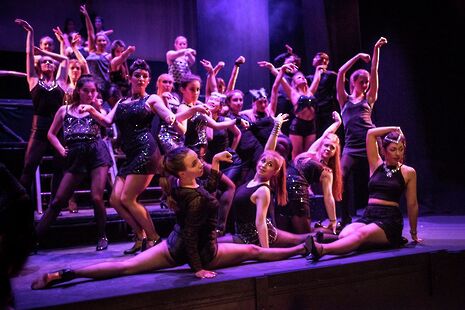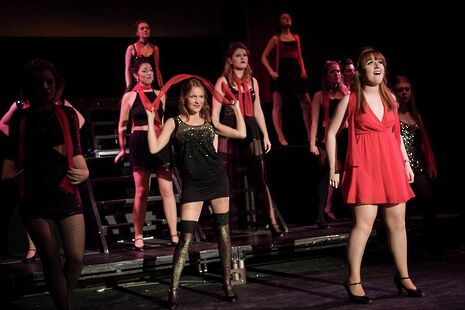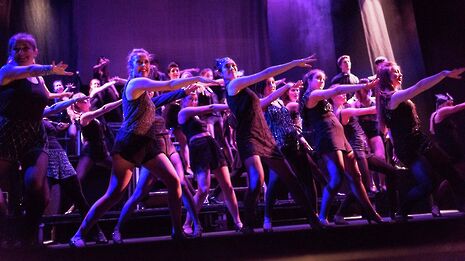Sweet Charity
Isabel Adomakoh-Young finds this ambitious musical to be wonderfully performed, but not without some integral flaws

Wow. I’m still reeling. I cannot imagine how director Tania Clarke got any work done this term, because this was an enormous project. With a cast of almost 50 and a 16-piece orchestra, Sweet Charity was one of the most ambitious, hilarious, all-singing all-dancing productions I’ve ever seen or heard of in Cambridge.
Fronted by the charismatic and multi-talented Rosalind Peters as dancehall hostess Charity Hope Valentine, the show took us on a whirlwind tour of both 1960s Manhattan and Charity’s love life, from the lake in Central Park that she ends up in one too many times, to an underground jazz church where thrusting hepcat Daddy encourages a tie-died, head-banded congregation to feel “the rhythm of life”. Charity herself is beautifully relatable: optimistic, vulnerable and witty (often without realising), partly thanks to Peters’s prodigious talent and partly because the script is just brilliant. Standout performances came from George Longworth as both Hollywood lothario Vittorio Vidal (with a slightly dodgy Italian accent) and Daddy, Sarah Mercer as Helene, a world-weary hostess, and Tom Beaven as endearing claustrophobe Oscar.

The ensemble numbers were what really hit home though, with up to 40 people in (almost) perfect step, tango-ing, show-tuning and jazz-handing through much-loved musical numbers like ‘Hey Big Spender’ and ‘I Love to Cry at Weddings’, as well as less known gems ‘There's Got to Be Something Better Than This’ and ‘I’m a Brass Band’ - with almost everyone singing, dancing and acting, that was a lot of talent to fit on one stage! Gratifying, too, to see the majority of ensemble members giving it their all, even though they were one of many; it really raised the energy.
Some of the issues lie with Bob Fosse’s Sweet Charity (show, 1965, film, 1969), rather than this production. Its lack of any real ending, for example, and its gender politics are slightly dubious in the cold light of modern feminism. Clarke and team took on these challenges boldly, but the decision to make the dancehall hostesses more aggressively sexualised jarred a bit with the largely period-specific (60s) show. They looked amazing, but I think Fosse’s original choreography lends itself more to the stylised than the overt - though dazzling numbers like Pompeii Club and Rhythm of Life paid tremendous tribute to his unique style.

The final minute however, even with technical issues aside, was truly weird, and it was hard to fathom the directorial decision that led to it. The set was also less than overwhelming; although there were some lovely uses of space and height, the rather half-hearted velvet hangings and wrinkly flats were not what we were expecting from a self-described "top-to-toe glamorous" production. We were left wondering, too, where the "Gatsby-esque high fashion" was when the ensemble came on in red cotton t-shirts and vests, although through most of the show the costuming was great.
My date was a musician who noted that as a first night performance, the inevitable, and thus of course forgivable, scruffiness of the orchestral accompaniment was at some points a little jarring (high trumpet notes occasionally ending up a little too ‘jazzy’, shall we say), but the musicians got into the swing of things eventually. The singers were all incredibly impressive, and once a few technical ruffles with the microphones are ironed out over the run, the vocal performances will really shine as much as they deserve to.
All in all, a huge amount of work and talent went into a wonderful if flawed show - but we’re in Cambridge, not on Broadway, and given that we left elated, with toes tapping and lines running through our heads, we couldn’t have asked for more.
 News / Downing investigates ‘mysterious’ underground burial vault 29 December 2025
News / Downing investigates ‘mysterious’ underground burial vault 29 December 2025 News / Unions protest handling of redundancies at Epidemiology Unit30 December 2025
News / Unions protest handling of redundancies at Epidemiology Unit30 December 2025 Lifestyle / Ask Auntie Alice29 December 2025
Lifestyle / Ask Auntie Alice29 December 2025 Features / ‘Treated like we’re incompetent’: ents officers on college micromanagement30 December 2025
Features / ‘Treated like we’re incompetent’: ents officers on college micromanagement30 December 2025 Science / Astronomical events to look out for over the break29 December 2025
Science / Astronomical events to look out for over the break29 December 2025









